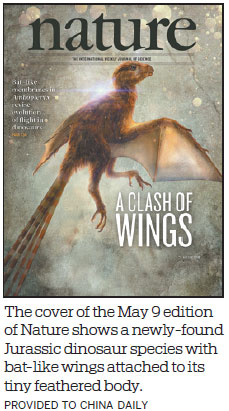Jurassic dinosaur with wings discovered
Chinese scientists have discovered an "extremely rare" and "fantastical" Jurassic dinosaur species in Liaoning province that roamed China's ancient forests with bat-like wings attached to its tiny feathered body some 163 million years ago.
The discovery of this new species suggests these pioneering fliers glided like bats with membranous rather than feathered wings like birds.
The research was conducted by scientists from the Institute of Vertebrate Paleontology and Paleoanthropology of the Chinese Academy of Sciences. The findings were featured on the cover of the journal Nature on Thursday.
The new species, Ambopteryx longibrachium, belongs to the Scansoriopterygidae, one of the most bizarre groups of non-avian theropods. A theropod is a carnivorous dinosaur of a group whose members are typically bipedal (two-legged).
"It is like a weird chimera of flying reptile, dinosaur and bird," said Wang Min, a researcher at the institute and lead author of the research paper.
From fossil records, scientists estimated the new dinosaur species was around 32 centimeters long and weighed about 306 grams.
The Scansoriopterygidae are so rare only three fossil species have previously been discovered. In 2015, Chinese scientists added the third entry to the list, Yi Qi, the first-ever dinosaur discovered with bat-like wings, which caused scientists to review their theories on the evolution of flight.

"We previously thought the evolutionary path from dinosaur to flying birds followed a linear path, with incremental changes to skeletal structure, feathers and soft tissue that ultimately made flight possible," Wang said.
"Now we are not so sure, because new fossil records show there are other ways in which flight evolved," he said.
Scansoriopterygidae differs from other theropods, with its high skull, slim limbs, short tails and extra-long third toe. "They closely resemble some birds rather than dinosaurs, and when we first acquired the fossil, we thought it was from an early bird," Wang said.
"But as we began cleaning and analyzing the fossil, we discovered weird proportions, membranes and a bizarre wing structure that was first found in Yi Qi," Wang said.
Wang said the newly discovered fossil is the most completely preserved and intriguing specimen of its group because it was from a fully grown adult with distinguishable features, unlike the first discovered member of the group, which was a juvenile.
Scientists found the first remnants of undigested stomach matter in the new fossil. They said these fliers might have been omnivorous.
"There are many unanswered questions; our discovery might just be the tip of the iceberg," Wang said. "We need to use new methods to examine the fossils further."
zhangzhihao@chinadaily.com.cn
(China Daily Global 05/10/2019 page3)


















